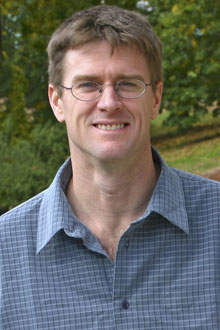| Sep 02, 2011 | |
Researchers explain how railways within cells are built in order to transport essential cargos |
|
| (Nanowerk News) Every cell in the human body contains a complex system to transport essential cargoes such as proteins and membrane vesicles from one point to another. These tiny molecular motor proteins move at high speeds on miniature railways carrying components of the cell to their proper destinations. It is critical that these railways are neither too long nor too short, as that would cause a misdirection of the proteins being transported. But just how cells construct these transport railways to fit precisely inside the confines of individual cells is a complex question. | |
 Professor Bruce Goodeption Bruce Goode, professor of biology, working in collaboration with the labs of Laurent Blanchoin in Grenoble, France, and Roland Wedlich-Soldner in Munich, Germany, has come one step closer to understanding the elusive mechanics of this process. In a recent paper published in the journal Developmental Cell ("The Myosin Passenger Protein Smy1 Controls Actin Cable Structure and Dynamics by Acting as a Formin Damper"), a team led by Goode's doctoral student Melissa Chesarone-Cataldo shows that the length of the railways is controlled by one of its "passenger proteins" that pauses during the journey to communicate with the protein machinery that is building the transport system. "The frequency of these chats between the passengers and builders may provide the feedback necessary to say a railway is long enough and construction should now slow down," says Goode. Much like a real construction site, a system must be in place to move the building materials. In this case, the roadways are cellular structures called actin cables; the transporters are myosin molecules, nanoscale motor proteins that rapidly deliver critical cargoes. Each cable is assembled from hundreds or thousands of copies of the protein actin, organized into long filaments. Nine years ago, Goode and his colleagues discovered that a family of proteins called formins stimulate the rapid growth of actin filaments. Recently, the team began to question how a cell tells formins when to speed up the assembly of actin filaments, when to slow down and when to stop altogether. |
|
| Enter Smy1, a passenger protein transported by myosin. | |
| Goode and his colleagues hypothesized that a passenger protein like Smy1 would provide the perfect mechanism for slowing down formins when roadways are longer and would be carrying more passengers. They tested their theory in yeast cells, where formins construct the actin cables that transport building materials essential for cell growth and division. As Goode puts it, they struck gold. | |
| When they deleted the gene for Smy1, cables grew abnormally fast and hit the back of the cell, buckling and misdirecting transport. When they purified Smy1 and placed it in a test tube with formins, they discovered that Smy1 slows down actin filament growth. | |
| To further explore, they tagged Smy1 in living cells and learned that Smy1 molecules are carried on cables by myosin to the formin, where they pause for one to two seconds to give formins the message to slow down. | |
| Goode says their working model illustrates that as a cable grows longer, it loads up more and more Smy1 molecules, which are transported on the cable to send a message to the formin to slow down. | |
| "This prevents overgrowth of longer cables that are nearing the back of the cell, but allows rapid growth of the shorter cables," says Goode. | |
| This paper will help scientists understand the general mechanisms that are used for directing cell shape and division. The next challenge, says Goode, is "to find out whether related mechanisms are used to control formins in mammalian cells and understand the physiological consequences of disrupting those mechanisms." |
| Source: By Susan Chaityn Lebovits, Brandeis University |
